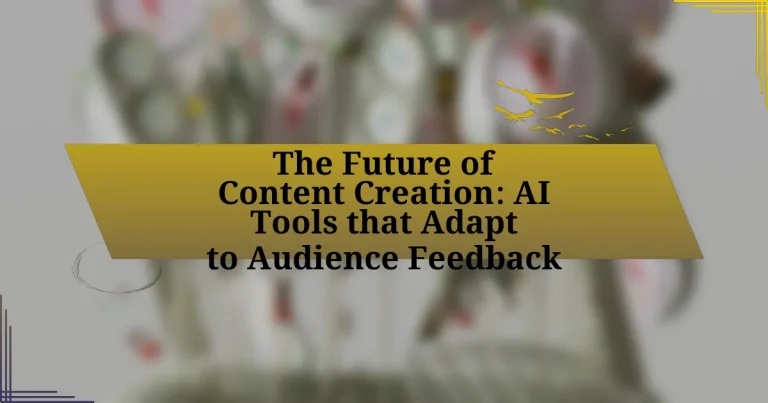The article focuses on the future of content creation through AI tools that adapt to audience feedback. It highlights how AI technologies, such as machine learning and natural language processing, enhance personalization and efficiency in content development. Key trends discussed include the increasing reliance on data analytics for tailoring content, the benefits of AI in improving engagement and productivity, and the challenges creators face in maintaining authenticity and ethical standards. The article also outlines practical strategies for maximizing the effectiveness of AI tools in engaging audiences and improving content quality.

What is the Future of Content Creation with AI Tools?
The future of content creation with AI tools is characterized by increased personalization and efficiency. AI tools will enable creators to analyze audience feedback in real-time, allowing for tailored content that meets specific viewer preferences. For instance, platforms like OpenAI’s GPT-3 have demonstrated the ability to generate contextually relevant content based on user interactions, enhancing engagement. Additionally, research from McKinsey indicates that companies leveraging AI in content creation can improve productivity by up to 40%, showcasing the transformative potential of these technologies in streamlining workflows and enhancing creative output.
How do AI tools adapt to audience feedback?
AI tools adapt to audience feedback by utilizing machine learning algorithms that analyze user interactions and preferences. These algorithms process data from user engagement metrics, such as likes, shares, comments, and viewing time, to identify patterns and trends in audience behavior. For instance, platforms like YouTube and Spotify employ recommendation systems that adjust content suggestions based on individual user feedback and collective audience trends, enhancing user experience and engagement. This adaptive capability is supported by continuous learning, where AI systems refine their models over time to improve accuracy in predicting audience preferences, ultimately leading to more relevant content delivery.
What technologies enable AI tools to analyze audience feedback?
Natural Language Processing (NLP), machine learning algorithms, and sentiment analysis technologies enable AI tools to analyze audience feedback. NLP allows AI to understand and interpret human language, facilitating the extraction of insights from textual feedback. Machine learning algorithms enhance the ability of AI tools to identify patterns and trends in audience responses, improving the accuracy of feedback analysis. Sentiment analysis specifically assesses the emotional tone behind the feedback, categorizing it as positive, negative, or neutral, which provides a deeper understanding of audience sentiment. These technologies collectively empower AI tools to deliver actionable insights based on audience feedback.
How do AI algorithms learn from audience interactions?
AI algorithms learn from audience interactions by analyzing data generated from user engagement, such as clicks, likes, comments, and shares. This data is processed to identify patterns and preferences, allowing the algorithms to adjust content recommendations and improve user experience. For instance, machine learning models utilize feedback loops where user interactions inform the algorithm about what content resonates with the audience, leading to more personalized and relevant outputs. Research has shown that algorithms can enhance their predictive accuracy by up to 30% when effectively utilizing audience interaction data, demonstrating the significant impact of user feedback on AI learning processes.
What are the key trends shaping the future of content creation?
Key trends shaping the future of content creation include the increasing use of artificial intelligence, personalization, and interactive content. Artificial intelligence tools are being developed to analyze audience feedback and preferences, enabling creators to tailor content more effectively. For instance, platforms like OpenAI’s ChatGPT and Google’s AI tools are enhancing content generation by providing insights based on user engagement metrics. Personalization is becoming essential, as 80% of consumers are more likely to make a purchase when brands offer personalized experiences. Additionally, interactive content, such as polls and quizzes, is gaining traction, with 93% of marketers stating that interactive content is effective in educating the audience. These trends indicate a shift towards more data-driven and audience-centric content strategies.
How is personalization influencing content strategies?
Personalization is significantly influencing content strategies by enabling brands to tailor their messaging and offerings to individual user preferences and behaviors. This approach enhances user engagement, as personalized content is more relevant and appealing to the audience. According to a study by Epsilon, 80% of consumers are more likely to make a purchase when brands offer personalized experiences. Furthermore, personalization leverages data analytics to understand audience segments, allowing for targeted content delivery that increases conversion rates and customer loyalty.
What role does data analytics play in content creation?
Data analytics plays a crucial role in content creation by providing insights into audience preferences and behaviors. By analyzing data from various sources, such as social media interactions, website traffic, and engagement metrics, content creators can identify what types of content resonate most with their target audience. For instance, a study by HubSpot found that companies using data-driven strategies for content creation see a 30% increase in engagement rates. This evidence underscores the importance of leveraging data analytics to tailor content effectively, ensuring it meets the needs and interests of the audience, ultimately leading to improved performance and relevance in the digital landscape.

What are the benefits of using AI tools in content creation?
AI tools in content creation enhance efficiency, improve personalization, and optimize engagement. These tools automate repetitive tasks, allowing creators to focus on strategic aspects of content development. For instance, AI can analyze audience data to tailor content that resonates with specific demographics, leading to higher engagement rates. According to a study by McKinsey, companies that leverage AI in marketing can increase their productivity by up to 40%. Additionally, AI tools can generate insights from audience feedback, enabling continuous improvement of content strategies.
How do AI tools enhance content quality?
AI tools enhance content quality by utilizing advanced algorithms to analyze data and optimize writing for clarity, engagement, and relevance. These tools can assess audience preferences and feedback, allowing creators to tailor content that resonates more effectively with their target demographic. For instance, AI-driven platforms like Grammarly and Hemingway provide real-time suggestions for improving grammar, style, and readability, which statistically leads to higher engagement rates. Research indicates that content optimized with AI tools can achieve up to 50% more shares and interactions on social media, demonstrating their significant impact on enhancing overall content quality.
What specific features improve content engagement?
Specific features that improve content engagement include interactive elements, personalization, and multimedia integration. Interactive elements, such as polls and quizzes, encourage user participation, leading to higher engagement rates. Personalization, achieved through data analysis, tailors content to individual preferences, making it more relevant and appealing to users. Multimedia integration, including videos and infographics, enhances the visual appeal and aids in information retention, which has been shown to increase user interaction. According to a study by HubSpot, content with relevant images gets 94% more views than content without.
How do AI tools streamline the content creation process?
AI tools streamline the content creation process by automating repetitive tasks and enhancing efficiency. These tools utilize natural language processing and machine learning algorithms to generate ideas, create drafts, and optimize content for SEO, significantly reducing the time required for content development. For instance, a study by the Content Marketing Institute found that 70% of marketers believe AI can improve content quality and speed. By analyzing audience feedback, AI tools can also tailor content to meet specific audience preferences, ensuring higher engagement and relevance.
What challenges do creators face when using AI tools?
Creators face several challenges when using AI tools, including issues related to accuracy, creativity, and ethical considerations. The reliance on AI can lead to inaccuracies in content generation, as AI may misinterpret context or produce irrelevant outputs. Additionally, creators often struggle to maintain their unique voice and style when integrating AI-generated content, which can dilute their brand identity. Ethical concerns also arise, particularly regarding copyright and the potential for AI to replicate existing works without proper attribution. These challenges highlight the need for creators to balance AI assistance with their own expertise and ethical standards in content creation.
How can creators ensure ethical use of AI in content creation?
Creators can ensure ethical use of AI in content creation by implementing transparency, accountability, and adherence to guidelines. Transparency involves clearly disclosing when AI tools are used in the creation process, allowing audiences to understand the role of AI in the content they consume. Accountability requires creators to take responsibility for the outputs generated by AI, ensuring that the content aligns with ethical standards and does not propagate misinformation or harmful stereotypes. Adhering to established guidelines, such as those from the AI Ethics Guidelines Global Inventory, helps creators navigate ethical considerations and maintain integrity in their work.
What are the limitations of current AI tools in understanding audience feedback?
Current AI tools face significant limitations in understanding audience feedback due to their reliance on pre-defined algorithms and lack of contextual comprehension. These tools often struggle with nuances in language, such as sarcasm or cultural references, which can lead to misinterpretation of sentiments. Additionally, AI systems may not effectively analyze feedback that is ambiguous or lacks clear sentiment indicators, resulting in incomplete insights. Research indicates that while AI can process large volumes of data quickly, it often fails to capture the emotional depth and complexity of human communication, which is essential for accurately gauging audience reactions.

How can creators effectively implement AI tools for audience engagement?
Creators can effectively implement AI tools for audience engagement by utilizing data analytics to understand audience preferences and behaviors. By analyzing metrics such as engagement rates, click-through rates, and audience demographics, creators can tailor their content to meet the specific interests of their audience. For instance, a study by McKinsey & Company found that companies using advanced analytics to drive audience engagement saw a 20% increase in customer satisfaction. Additionally, creators can leverage AI-driven chatbots to facilitate real-time interaction, providing personalized responses and enhancing user experience. This approach not only fosters a sense of community but also allows creators to gather immediate feedback, which can be used to refine future content strategies.
What best practices should be followed when using AI tools?
When using AI tools, best practices include ensuring data privacy, maintaining transparency, and continuously monitoring performance. Ensuring data privacy involves implementing robust security measures to protect user information, as breaches can lead to significant legal and reputational consequences. Maintaining transparency is crucial; users should be informed about how AI tools operate and the data they utilize, fostering trust and ethical use. Continuously monitoring performance allows for the identification of biases and inaccuracies, which can be addressed to improve the tool’s effectiveness. These practices are supported by guidelines from organizations like the European Commission, which emphasizes ethical AI use and accountability.
How can creators measure the effectiveness of AI-driven content?
Creators can measure the effectiveness of AI-driven content through metrics such as engagement rates, conversion rates, and audience feedback. Engagement rates, including likes, shares, and comments, provide quantitative data on how well the content resonates with the audience. Conversion rates indicate the percentage of users who take a desired action, such as signing up for a newsletter or making a purchase, directly linked to the AI-generated content. Additionally, analyzing audience feedback through surveys or sentiment analysis tools can offer qualitative insights into the content’s impact. These metrics collectively help creators assess the performance and relevance of their AI-driven content in real-time.
What strategies can enhance audience interaction with AI-generated content?
To enhance audience interaction with AI-generated content, implementing personalized content recommendations is crucial. Personalization increases engagement by tailoring content to individual preferences, which has been shown to improve user satisfaction and retention rates. For instance, a study by McKinsey & Company found that personalized experiences can lead to a 10-30% increase in engagement. Additionally, incorporating interactive elements such as polls, quizzes, and comment sections allows audiences to actively participate, fostering a sense of community and connection. Research from the Nielsen Norman Group indicates that interactive content can boost user engagement by up to 70%. Lastly, utilizing real-time feedback mechanisms enables creators to adapt content based on audience responses, ensuring relevance and enhancing interaction.
What future developments can we expect in AI content creation tools?
Future developments in AI content creation tools will likely include enhanced personalization and real-time audience feedback integration. These advancements will enable tools to analyze user interactions and preferences, allowing for the generation of tailored content that resonates more effectively with specific audiences. For instance, recent trends indicate that AI systems are increasingly utilizing machine learning algorithms to adapt content based on engagement metrics, which can lead to higher user satisfaction and retention rates. Additionally, the incorporation of natural language processing improvements will facilitate more nuanced and context-aware content generation, making AI tools more versatile and user-friendly.
How might advancements in AI technology change content creation dynamics?
Advancements in AI technology will significantly change content creation dynamics by enabling more personalized and efficient content generation. AI tools can analyze audience preferences and feedback in real-time, allowing creators to tailor their content to meet specific audience needs. For instance, platforms like OpenAI’s GPT-3 have demonstrated the ability to generate high-quality text based on user input, which can streamline the writing process and enhance creativity. Additionally, AI can automate repetitive tasks, such as editing and formatting, freeing up creators to focus on more strategic aspects of content development. This shift not only increases productivity but also fosters a more interactive relationship between creators and their audiences, as AI can facilitate immediate adjustments based on viewer engagement metrics.
What emerging trends should creators watch for in AI tools?
Creators should watch for the trend of AI tools increasingly utilizing real-time audience feedback to enhance content personalization. This trend is driven by advancements in machine learning algorithms that analyze user interactions and preferences, allowing creators to tailor their content more effectively. For instance, platforms like YouTube and Spotify are already implementing AI-driven recommendations based on user behavior, which significantly boosts engagement rates. Additionally, the rise of generative AI tools enables creators to produce customized content at scale, responding dynamically to audience trends and preferences. This shift towards data-driven content creation is supported by research indicating that personalized experiences can lead to higher viewer retention and satisfaction.
What practical tips can help creators maximize AI tools for content creation?
Creators can maximize AI tools for content creation by leveraging data analytics to understand audience preferences and tailoring content accordingly. Utilizing AI-driven insights allows creators to identify trending topics, optimize content for SEO, and personalize user experiences. For instance, tools like Google Analytics provide real-time data on audience engagement, enabling creators to adjust their strategies effectively. Additionally, employing AI writing assistants can enhance productivity by generating drafts and suggesting improvements, which streamlines the creative process. By integrating these AI capabilities, creators can produce more relevant and engaging content that resonates with their audience.

